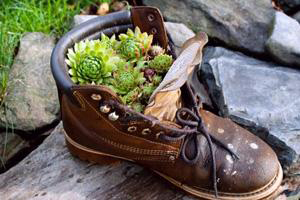 April 16, 2020 - By Brian David and Bob Labozetta (UC Master Gardeners, Mariposa) - Container gardening can solve many problems that plague the backyard gardener. It can add color to otherwise drab patios and decks. It’s easier to control pH. Cold or heat sensitive plants can be moved throughout the season(s) to more protective areas. It also allows gardeners with physical limitations to enjoy this hobby more extensively.
April 16, 2020 - By Brian David and Bob Labozetta (UC Master Gardeners, Mariposa) - Container gardening can solve many problems that plague the backyard gardener. It can add color to otherwise drab patios and decks. It’s easier to control pH. Cold or heat sensitive plants can be moved throughout the season(s) to more protective areas. It also allows gardeners with physical limitations to enjoy this hobby more extensively.
The drawbacks of container gardening—primarily that container plants need to be watered and fertilized more frequently and need to be repotted periodically—are worth the effort for a beautiful and flexible garden space.
 Container gardening allows for a broad spectrum of plants—from vegetables, berries and fruit trees to flowering ornamentals. By moving the pot, you can change plant’s environment, and yours.
Container gardening allows for a broad spectrum of plants—from vegetables, berries and fruit trees to flowering ornamentals. By moving the pot, you can change plant’s environment, and yours.
A container’s size and material composition matters. Clay pots are porous, plastic is impermeable. Nearly all containers are suitable for container gardening if properly prepared. A container needs at least one drainage hole covered with a piece of fine wire or nylon cloth. Without proper drainage water pools, drowning the plant’s roots and depriving the roots of oxygen.
Before planting in a pre-used container be sure the container is sterilized using nine-parts water to one-part chlorine.
Overwatering is the primary cause of death for container plants. To determine your soil’s moisture, place your finger in the soil up to your knuckle. If the soil sticks to your finger, your water content is usually sufficient. If the soil feels dry, you should water your plant. A technical way to test your container plant’s water needs is to use a moisture meter.
 The smaller and more porous a container the more water your plant will need. Hot or windy conditions warrant checking moisture content daily. Two ways to protect your plants from dehydrating through California’s long hot dry season are, (1) to insulate your container by double potting (2) to keep containers off hot reflective surfaces.
The smaller and more porous a container the more water your plant will need. Hot or windy conditions warrant checking moisture content daily. Two ways to protect your plants from dehydrating through California’s long hot dry season are, (1) to insulate your container by double potting (2) to keep containers off hot reflective surfaces.
Potted plants have limited nutrients available, so they need amendments supplied every 60-180 days. Most potting soil mixes provide a few months’ worth of nutrients. Container soil cannot regenerate so it needs regular feeding and occasional changing. You want a porous, sterile potting soil that allows water and air to reach the roots of the plants. Only apply amendments to hydrated plants. As plants mature check for over extended or bound roots which may require a larger container.
Container plants depend on gardeners for survival. Think outside the box and expand your gardening palette! Let your garden grow!
Photo credit: Gail Mason
The U.C. Master Gardener Helpline is staffed; Thursdays from 2:00 p.m. - 5:00 p.m.
Serving Mariposa County, including Greeley Hill, Coulterville and Lake Don Pedro
Please contact the helpline, or leave a message by phone at: (209) 966-7078
By email (send photos and questions for researched answers) to: mgmariposa@ucdavis.edu
For further gardening information and event announcements, please visit: UCMG website: http://cemariposa.ucanr.edu/Master_Gardener
Follow us on Facebook at: https://www.facebook.com/mariposamastergardeners
Master Gardener Office Location:
UC Cooperative Extension Office,
5009 Fairgrounds Road
Mariposa, CA 95338
Phone: (209) 966-2417
Email: mgmariposa@ucdavis.edu
Website: http://cemariposa.ucanr.edu/Master_Gardener
